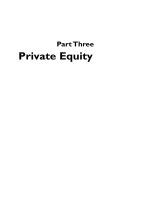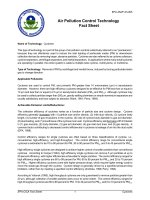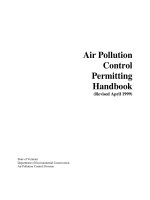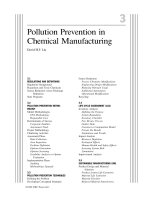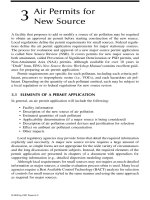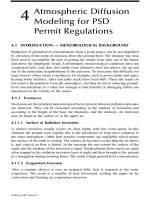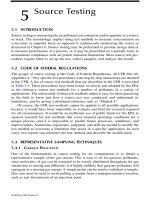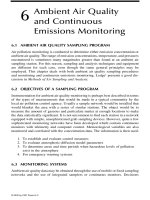AIR POLLUTION CONTROL TECHNOLOGY HANDBOOK - CHAPTER 3 ppt
Bạn đang xem bản rút gọn của tài liệu. Xem và tải ngay bản đầy đủ của tài liệu tại đây (165.64 KB, 12 trang )
Air Permits for
New Source
A facility that proposes to add or modify a source of air pollution may be required
to obtain an approved air permit before starting construction of the new source.
Local regulations define the permit requirements for small sources. Federal regula-
tions define the air permit application requirements for major stationary sources.
The process for evaluation and approval of a new major source permit application
is called New Source Review (NSR). It covers permits for new major sources in
both attainment, called Prevention of Significant Deterioration or PSD permits, and
Non-Attainment Area (NAA) permits. Although available for over 10 years in
“Draft” form, EPA’s
New Source Review Workshop Manual
contains excellent guid-
ance for preparing an air permit application.
1
Permit requirements are specific for each pollutant, including each criteria pol-
lutant, precursors to tropospheric ozone (i.e., VOCs), and each hazardous air pol-
lutant. Depending on the quantity of each pollutant emitted, each may be subject to
a local regulation or to federal regulations for new source review.
3.1 ELEMENTS OF A PERMIT APPLICATION
In general, an air permit application will include the following:
• Facility information
• Description of the new source of air pollution
• Estimated quantities of each pollutant
• Applicability determination (if a major source is being considered)
• Description of air pollution control devices and justification for selection
• Effect on ambient air pollutant concentration
• Other impacts
Local regulatory agencies may provide forms that detail the required information
explicitly and succinctly. A major new source review requires a large amount of
discussion, so simple forms are not appropriate for the wide variety of circumstances
and the long discussions of pertinent subjects. Instead, the required elements of the
permit application are presented in chapters of a document with appendices for
supporting information (e.g., detailed dispersion modeling output).
Although local requirements for small sources may not require as much detailed
information as major sources, a similar evaluation process often is used. Many local
agencies require a Best Available Control Technology (BACT) analysis for selection
of controls for small sources styled in the same manner and using the same approach
as required for major sources.
3
9588ch03 frame Page 33 Wednesday, September 5, 2001 9:42 PM
© 2002 by CRC Press LLC
Interestingly, a permit application for a new major source in a non-attainment
area may require less information that a PSD permit application in an attainment
area. The reason is because some of the information, such as cost effectiveness of
control equipment and PSD increment consumption, is moot. Control equipment for
new sources in a non-attainment area must meet Lowest Achievable Emission Rate
(LAER), where cost effectiveness is not a consideration.
3.1.1 A
PPLICABILITY
Applicability must be evaluated to determine which regulations apply to a new
source. Three basic criteria are considered: (1) whether the source is sufficiently
large to be considered a “major” stationary source; (2) if the source is in an attainment
area; and (3) if “significant” amounts of specific pollutants will be emitted.
A stationary source is considered to be “major” if the “potential to emit” exceeds
the specified major source threshold. The threshold for industrial categories listed
in Table 3.1 is 100 tons per year of any regulated pollutant except the listed hazardous
air pollutants. For all other industrial categories, the threshold is 250 tons per year.
However, as discussed in Chapter 2, the emission threshold for a “major” source is
reduced in ozone non-attainment areas, bringing smaller facilities into the scrutiny
of federal new source review requirements in those areas.
3.1.1.1 Potential to Emit
Potential to emit (PTE) is the amount of pollution that a facility is capable of emitting
at the maximum design capacity of the facility, except as constrained by federally
enforceable conditions. The PTE is determined separately for each pollutant. Fed-
erally enforceable conditions are permit restrictions that can be verified, such as
installed air pollution control equipment at prescribed efficiency, restrictions on
hours of operation, and restrictions on the raw materials or fuel that is burned, stored,
or processed. The facility must be able to show continual compliance (or noncom-
pliance) with each limitation through testing, monitoring, and/or recordkeeping.
3.1.1.2 Fugitive Emissions
Fugitive emissions, to the extent that they are quantifiable, are included in the PTE
and in subsequent impact analysis. Fugitive emissions are emissions that cannot
reasonably be collected and pass through a stack, vent, or similar opening. Examples
include particulate matter from coal piles, roads, and quarries, and VOC emissions
from leaking valves, flanges, and pump seals at refineries and organic chemical
plants.
3.1.1.3 Secondary Emissions
Secondary emissions are not considered as part of the potential to emit. Secondary
emissions are associated with the source, but are not emitted from the source itself.
For example, a production increase from a new cement plant could require increased
emissions at the adjacent quarry owned by another company. Increased secondary
9588ch03 frame Page 34 Wednesday, September 5, 2001 9:42 PM
© 2002 by CRC Press LLC
emissions at the quarry would not be included in the cement plant’s PTE. However,
if they are specific, well-defined, quantifiable, and impact the same general area as
the cement plant, they would be considered in the discussion of the cement plant’s
ambient impacts analysis.
3.1.2 S
IGNIFICANT
E
MISSION
R
ATES
The significant emission rate thresholds, often called the “PSD trigger,” for federal NSR
for specific pollutants are listed in Table 3.2. In attainment areas, any new or modified
source emissions at a major source facility that increases the PTE of any of these
pollutants by the significant emission rate triggers the requirement for a PSD permit.
There is a second criterion for significant emission threshold. If any new major
stationary source is constructed within 10 km of a Class I area and if the potential
emissions would increase the 24-hour average concentration of any regulated air
pollutant by 1.0
µ
g/m
3
or more, then a PSD review is triggered.
TABLE 3.1
PSD Source Categories with Major Source Threshold of 100 tpy
Fossil-fuel-fired steam electric plants of more than 250 million BTU/h heat input
Coal cleaning plants (with thermal dryers)
Kraft pulp mills
Portland cement plants
Primary zinc smelters
Iron and steel mill plants
Primary aluminum ore reduction plants
Primary copper smelters
Municipal incinerators capable of charging more than 250 tons of refuse per day
Hydrofluoric acid plants
Sulfuric acid plants
Nitric acid plants
Petroleum refineries
Lime plants
Phosphate-rock processing plants
Coke oven batteries
Sulfur recovery plants
Carbon black plants (furnace plants)
Primary lead smelters
Fuel conversion plants
Sintering plants
Secondary metal production plants
Chemical process plants
Fossil fuel boilers (or combinations thereof) totaling more than 250 million BTU/h heat input
Petroleum storage and transfer units with a total storage capacity exceeding 300,000 barrels
Taconite ore processing plants
Glass fiber processing plants
Charcoal production plants
9588ch03 frame Page 35 Wednesday, September 5, 2001 9:42 PM
© 2002 by CRC Press LLC
3.1.3 M
ODIFICATION
A “modification” is generally a physical change or a change in the method of
operation that results in an increase of air pollutant emissions, and a NSR for a
modification is treated in the same way as for a new source. Existing sources that
are not modified generally are “grandfathered” with no change in their existing
pollution controls, although existing sources in nonattainment areas may be required
to install Reasonably Available Control Technology (RACT) for criteria pollutants,
and existing sources of hazardous air pollutants may be regulated by the Maximum
Achievable Control Technology (MACT) standards for hazardous air pollutants as
discussed in the previous chapter.
A modification is subject to PSD review only if the existing source is a “major”
stationary source and if the net emissions increase of any pollutant emitted by the
source is equal to or greater than the “significant emission rate.” The regulations do
not define “physical change” or “change in the method of operation” precisely.
However, they specifically exclude certain activities, including:
• Routine maintenance, repair, and replacement
• A fuel switch due to an order under the Energy Supply and Environmental
Coordination Act of 1974 (or any superceding legislation) or due to a
natural gas curtailment plan under the Federal Power Act
• A fuel switch due to an order or rule under section 125 of the CAA
• A switch at a steam generating unit to a fuel derived in whole or in part
from municipal solid waste
TABLE 3.2
Significant Emission Rates for Federal New Source Review
Pollutant
Significant Emission Rate
(tons per year)
Carbon monoxide 100
Nitrogen oxides (all oxides of nitrogen) 40
Sulfur dioxide 40
Particulate matter
PM
10
25
15
VOC (ozone precursor) 40
Lead 0.6
Asbestos 0.007
Beryllium 0.0004
Mercury 0.1
Vinyl chloride 1
Fluorides 3
Sulfuric acid mist 7
Hydrogen sulfide 10
Total reduced sulfur compounds including H
2
S10
9588ch03 frame Page 36 Wednesday, September 5, 2001 9:42 PM
© 2002 by CRC Press LLC
• A switch to a fuel or raw material which (a) the source was capable of
accommodating before January 6, 1975, so long as the switch would not
be prohibited by any federally enforceable permit condition established
after that date under a federally approved SIP (including any PSD permit
condition) or a federal PSD permit, or (b) the source is approved to make
under a PSD permit
• Any increase in the hours or rate of operation of a source, so long as the
increase would not be prohibited by any federally enforceable permit
condition established after January 6, 1975 under a federally approved
SIP (including any PSD permit condition) or a federal PSD permit
• A change in ownership of a stationary source
3.1.4 E
MISSIONS
N
ETTING
In determining the change in emissions that result from a modification at an existing
source, other contemporaneous increases and decreases can be considered. A facility
may increase NO
x
emissions with one project, and decrease NO
x
emissions at nearly
the same time with another project. The net NO
x
emissions may be less than the
significant emission rate for NO
x
, and the projects could “net out of PSD.” Avoiding
the scrutiny of a PSD permit approval process may have advantages for the facility,
including different agency jurisdiction for the review, fewer agencies involved in the
process, and no PSD increment evaluation. The advantage to the environment is the
incentive for reducing emissions while allowing improvements at existing facilities
to proceed.
The net emissions change equals the emissions increases associated with the
proposed modification minus source-wide creditable contemporaneous emissions
decreases plus source-wide creditable contemporaneous emissions increases. The
increases and decreases are changes in actual emissions (not permitted or potential
emissions). They must be at the same major source facility. They cannot be traded
between facilities. And the netting equation is pollutant specific.
The contemporaneous time period is defined by federal regulations as 5 years
before the date that construction on the proposed modification is expected to com-
mence. Changes older than the contemporaneous period are not considered. Many
states to which jurisdiction for the PSD program has been delegated by the EPA have
developed regulations with different time periods for the definition of contemporane-
ous. Where approved by the EPA, these time periods are used. Establishing the exact
dates for the contemporaneous time period can be very important and a bit difficult
to determine. Since the date that construction will commence is unknown when the
permit application is prepared and reviewed, the scheduled date may be used. The date
of increases and decreases is set when the changed emission unit becomes operational,
which may be after a reasonable shakedown period that does not exceed 180 days.
3.1.4.1 Netting Example
A major source proposes a modification to its facility that would result increasing
the potential to emit by 35 tons per year (tpy) NO
x
, 80 tpy SO
2
, and 25 tpy particulate
9588ch03 frame Page 37 Wednesday, September 5, 2001 9:42 PM
© 2002 by CRC Press LLC
matter less than 10 microns (PM
10
). Two years ago, the facility incorporated a smaller
modification that increased the potential to emit by 30 tpy NO
x
, 15 tpy SO
2
, and
5 tpy PM
10
, all of which were less than the significant amounts that would trigger
a PSD review for that modification. Three years ago, the facility made a change that
decreased actual emissions by 10 tpy NO
x
, 50 tpy SO
2
, and 20 tpy PM
10
. The facility
applied for and received emission reduction credits for the decreased emissions.
Since the proposed increase in NO
x
emissions of 35 tpy is less than the significant
amount of 40 tpy, a PSD review for NO
x
is not required. The net increase in potential
SO
2
emissions is 45 tpy (+80 +15 –50), which is greater than the PSD trigger and
a PSD review for SO
2
is required. The net increase in potential particulate matter
emissions is +10 tpy (+25 +5 –20), which is less than the PSD trigger and a PSD
review for PM
10
is not required.
3.2 BEST AVAILABLE CONTROL TECHNOLOGY
The Federal New Source Review program requires that Best Available Control
Technology (BACT) be applied to major new sources and major modifications in
attainment areas. Many local agencies also require that BACT be applied to smaller
new sources of air pollution. Often the selection of control technology does not
depend on whether a PSD review is triggered because the same control technology
will be required in any case.
BACT is a technology-based standard that can be met by available technology.
Typically it is specified in an air permit as a maximum emission rate or concentration
that can be monitored and verified. Frequently one will read or hear a vendor’s
advertisement that their technology is BACT for a type of emission source. More
precisely, they mean that their technology usually is accepted by permitting agencies
as the technology that will be used to control emissions to a specified limit. BACT
is determined on a case-by-case basis as the technology that will provide the max-
imum degree of reduction taking into account energy, environmental, and economic
impacts and other costs. The permit applicant proposes BACT for the proposed
project and provides a detailed BACT analysis to support their proposal. The per-
mitting agency reviews the permit application for completeness and accuracy, and
may approve the proposed technology and emission limitation, reject it, or request
more information.
BACT may be differentiated from other acronymed technologies. Reasonable
Available Control Technology (RACT) applies to retrofits for existing sources in
nonattainment areas while BACT applies to new and modified sources. Lowest
Achievable Emission Rate (LAER) applies to new and modified sources in nonat-
tainment areas while BACT applies to areas that are in attainment of the NAAQS.
Maximum Achievable Control Technology (MACT) applies to hazardous air pollut-
ants from industrial point sources while BACT applies to criteria pollutants. Gen-
erally Available Control Technology (GACT) applies to hazardous air pollutants
from area sources, which is any stationary source of hazardous air pollutants that is
not a major source.
9588ch03 frame Page 38 Wednesday, September 5, 2001 9:42 PM
© 2002 by CRC Press LLC
Some local agencies adopt additional distinctions for control technologies. Best
Available Retrofit Control Technology (BARCT) is used in California for existing
sources in nonattainment areas, just like RACT. It may be difficult to distinguish
between BARCT and RACT, although both are based on judgment resulting from
an evaluation of the source and situation, and BARCT is sometimes more stringent
than RACT for a given source type.
2
Toxic Best Available Control Technology
(T-BACT) is used by some local agencies for new sources of toxic air pollutants.
Cost effectiveness is a very important part of BACT, whereas it is not considered
when selecting the LAER for new sources in NAAQS non-attainment areas. One
also frequently anticipates permitting agencies to be looking for a specific cost
effectiveness, expressed as dollars per ton of pollutant removed, when they accept
BACT. Agencies, meanwhile, are reluctant to establish a firm threshold for cost
effectiveness, because a BACT analysis is more than a simple economic evaluation
and needs to take other criteria into account. This makes it difficult for an applicant
to judge what an agency considers to be cost effective. Precedent, both locally and
nationally, can be used as a guide.
The EPA has adopted a “top down” methodology for determining BACT. This
means that the control technology with the highest degree of pollutant reduction
must be evaluated first. If that technology meets all of the criteria for feasibility,
cost effectiveness, air quality impacts, and other impacts, it is determined to be
BACT for the proposed new source and the analysis ends. If not, the next most
effective control technology is evaluated for BACT. The “top down” approach is
rigorous, and drives using the highest reduction technology that is considered cost-
effective by the agency rather than more cost effective compromises that would be
desired by an applicant.
As a minimum level, BACT must at least meet the emission limitations of New
Source Performance Standards (NSPS). Established NSPS have already been based
on a thorough technology and economic evaluation. But as control technology
improves, BACT may become more stringent than NSPS.
3.2.1 S
TEP
1: I
DENTIFY
C
ONTROL
T
ECHNOLOGIES
First, potential control technologies are identified. The potential technologies include
those that are used outside of the U.S. and those that are used for similar emission
sources. Innovative control technologies may be included, but if a technology has
not been commercially demonstrated and if it is not commercially available, then it
is not considered to be a potential for “available” control technology.
This step takes some research. As a minimum, research should include EPA’s
Office of Air Quality Planning and Standards Technology Transfer Network Clean
Air Technology Center RACT/BACT/LAER Clearinghouse <www.epa.gov/ttn/catc>.
Agencies use this database to post permit application emission limits, technologies,
and restrictions for other agencies and applicants to use for just this purpose.
Technical books and journals are another common source of technology information.
Internet searches now can be quite valuable. Control equipment vendors often are
invaluable sources of information, although one must bear in mind their vested
9588ch03 frame Page 39 Wednesday, September 5, 2001 9:42 PM
© 2002 by CRC Press LLC
interest in selling their equipment. Environmental consultants often are hired to
prepare permit applications because of their prior knowledge of control technologies
and permit application requirements. Less common, but acceptable, sources of
information include technical conference reports, seminars, and newsletters.
Agencies typically expect a reasonably complete list, but it does not have to be
exhaustive. Agency personnel use their own knowledge of the industry to check for
completeness, and will request additional information for a potential technology if
they believe a good possibility has been left out.
3.2.2 S
TEP
2: E
LIMINATE
T
ECHNICALLY
I
NFEASIBLE
O
PTIONS
Some of the potential control technologies may not work in the specific application
being proposed. To be technically feasible, the control technology must be available
and applicable to the source. Technical infeasibility may be based on physical,
chemical, or engineering principles. Technical judgment must be used by the appli-
cant and the reviewing agency in determining whether a control technology is
applicable to the specific source.
For example, while modifying a process heater, low-NO
x
burners might not be
able to be retrofit into the heater due to its configuration. The longer flame length
produced by low-NO
x
burners may impinge on the back wall of the heater.
Demonstrating unresolvable technical difficulty due to the size of the unit,
location of the proposed site, or operating problems related to specific circumstances
could show technical infeasibility. However, when the resolution of technical diffi-
culties is a matter of cost, the technology should be considered technically feasible,
and let the economic evaluation determine if the cost is reasonable. There may be
instances where huge cost can solve many problems. Judgment should be exercised
to avoid wasteful effort in detailed economic evaluations that don’t stand a chance
of being reasonable.
3.2.3 S
TEP
3: R
ANK
R
EMAINING
O
PTIONS
BY
C
ONTROL
E
FFECTIVENESS
All remaining control technologies that are not eliminated during Step 2 are ranked
in order of control effectiveness for the pollutant under review. While seemingly
straightforward, two key issues must be addressed in this step. The first is ensuring
that a comparable basis is used for emission reduction capability. Calculating poten-
tial emissions on a basis of mass per unit production, i.e., pounds SO
2
per million
BTU heat input, can help.
A more difficult problem arises for control techniques that can operate over a
wide range of emission performance levels, depending on factors such as size (e.g.,
a large electrostatic precipitator vs. a small one) and operating parameters (e.g.,
scrubber recirculation rate and reagent concentration). Every possible level of effi-
ciency does not have to be analyzed. Again, judgment is required. Recent regulatory
decisions and performance data can help identify practical levels of control. This
reduces the need to analyze extremely high levels in the range of control. By spending
a huge amount of money and installing a huge electrostatic precipitator, an extremely
high particulate removal efficiency is theoretically possible. However, as discussed
9588ch03 frame Page 40 Wednesday, September 5, 2001 9:42 PM
© 2002 by CRC Press LLC
in Chapter 24, there are practical limitations to theoretical performance. Demon-
strated performance is critical to the evaluation of available technology. Also, it
generally is presumed that demonstrated levels of control can be achieved unless
there are source-specific factors that limit the effectiveness of the technology. This
eliminates the need to analyze lower levels of a range of control.
3.2.4 S
TEP
4: E
VALUATE
C
ONTROL
T
ECHNOLOGIES
IN
O
RDER
OF
C
ONTROL
E
FFECTIVENESS
Starting with the feasible technology having the highest pollutant removal perfor-
mance, the technology is evaluated for energy impacts, environmental impacts (other
than air quality, which will be analyzed in detail in another section of a new source
permit application), and economic impacts. Both adverse and beneficial effects
should be discussed, and supporting information should be presented.
3.2.4.1 Energy Impacts
Many control technologies either consume or produce energy or change the amount
of energy that is produced by the process. Thermal oxidation of volatile organics in
a concentrated gas stream may be an example of energy production if that energy
can be recovered and put to use.
Energy and energy conservation is considered by the government to be important
to the economy of the nation, and the energy analysis assures that energy has been
considered. However, quantitative thresholds for energy impacts have not been
established, so it is difficult to reject a technology based on energy alone. There
may be a circumstance where the required energy is not available at the proposed
source. The cost of energy will be considered separately in the economic evaluation.
The energy evaluation should consider only direct energy consumption by the
control technology. Indirect energy consumption that should not be considered
includes the energy required to produce the raw materials for the control technology
(e.g., the heat required to produce lime from limestone) and for transportation of
raw materials and byproducts.
3.2.4.2 Environmental Impacts
This section of the BACT analysis provides information about environmental impacts
other than air quality. A detailed discussion of pollutant concentration in ambient
air must be provided separately in the air permit application. This discussion of
environmental impacts includes topics such as creation of solid or hazardous waste
(e.g., as byproducts of the control technology or as spent catalyst), wastewater, excess
water use in an area with inadequate supply, emissions of unregulated air pollutants,
and destruction of critical habitat. It also contains an evaluation of impacts on
visibility. Both positive and negative impacts should be discussed.
That a control technology generates liquid or solid waste or has other environ-
mental impacts does not necessarily eliminate the technology as BACT. Rather, if
the other impacts create significant environmental problems, there may be a basis
9588ch03 frame Page 41 Wednesday, September 5, 2001 9:42 PM
© 2002 by CRC Press LLC
for elimination. Site-specific and local issues may define what problems are consid-
ered to be “significant.”
3.2.4.3 Economic Impacts and Cost Effectiveness
The section on economic impacts and cost effectiveness tends to be more objective
than the energy and environmental impacts sections because costs are quantified in
terms of dollars spent per ton of pollutant reduced. The focus is the cost of control,
not the economic situation of the facility.
The primary factors required to calculate cost effectiveness, defined as dollars
per ton of pollutant reduced, are the emission rate, the control effectiveness, the
annualized capital cost of the control equipment, and the operating cost of the control
equipment. With these factors, the cost effectiveness is simply the annualized capital
and operating costs divided by the amount of pollution controlled by the technology
in 1 year.
Estimating and annualizing capital costs are discussed in Chapter 7. Total capital
cost includes equipment, engineering, construction, and startup. Annual operating
costs include operating, supervisory, and maintenance labor, maintenance materials
and parts, reagents, utilities, overhead and administration, property tax, and insurance.
In addition to the overall cost effectiveness for a control technology, the incre-
mental cost effectiveness between dominant control options can be presented. The
incremental cost effectiveness is the difference in cost between two dominant tech-
nologies divided by the difference in the pollution emission rates after applying
these two technologies. An extraordinarily high incremental cost effectiveness can
be used as justification that a control technology having only slightly higher removal
efficiency than the next technology, but which has significantly higher cost, is not
cost effective.
The incremental cost effectiveness approach sometimes can be used to establish
the practical limits for technologies with variable removal efficiency. For example,
an electrostatic precipitator with 98% removal efficiency may be considered by an
applicant to be cost effective. But to achieve 99.5% efficiency, a much larger and
more expensive precipitator would be required. The large additional cost for a small
improvement in efficiency is not cost effective.
3.2.5 S
TEP
5: S
ELECT
BACT
Step 4 is repeated for each technology in order of the control effectiveness established
in Step 3 until one of the technologies is not eliminated by the evaluation. The most
effective level of control that is not eliminated by the evaluation is proposed by the
applicant to be BACT. It is not necessary to continue evaluating technologies that
have lower control effectiveness.
The permitting agency will review the application for completeness and accu-
racy, and is responsible for assuring that all pertinent issues are addressed before
approving the application. The ultimate BACT decision is made by the agency after
public comment is solicited and public review is held and comments are addressed.
9588ch03 frame Page 42 Wednesday, September 5, 2001 9:42 PM
© 2002 by CRC Press LLC
3.3 AIR QUALITY ANALYSIS
Each PSD source or modification must perform an air quality analysis to demonstrate
that its new pollutant emissions would not violate either the applicable NAAQS or
the applicable PSD increment. To determine if a new industrial source of air pollution
can be established in any area, the projected increase in ambient pollutant concen-
tration must be determined using dispersion modeling. If the proposed source is
large and if there is any doubt that either the allowed increment could be exceeded
or that the NAAQS could be approached, air permitting agencies may require up to
2 years of ambient air monitoring to establish accurate background concentrations.
Additional monitoring may be required after the source starts up to ensure that
modeling calculations did not underpredict the effect of the new source.
3.3.1 P
RELIMINARY
A
NALYSIS
A preliminary dispersion modeling analysis is first performed to: (1) determine whether
the applicant can forego further air quality analyses for a particular pollutant; (2) allow
the applicant to be exempted from ambient monitoring data requirements; and
(3) determine the impact area within which a full impact analysis must be carried out.
The levels of significance for air quality impacts in Class II areas are listed in Table 3.3.
If a proposed source is located within 100 km of a Class I area, an impact of 1
µ
g/m
3
on a 24-h basis is significant. If the projected increase in pollutant concentration is
less than the significance level for the appropriate time averaging period, then it is
considered “insignificant,” and an evaluation of PSD increment consumption is not
required. Also, the available increment is not reduced by projects having an insignif-
icant impact, so future PSD increment analyses can neglect these small projects.
Sometimes a simple, conservative screening model can be used to quickly
demonstrate that a new source is insignificant. The SCREEN model can be down-
loaded from the EPA OAQPS Technology Transfer network web page. This model
TABLE 3.3
Significance Levels for Air Quality Impacts in Class II Areas
Time Averaging Period
Pollutant Annual 24-h 8-h 3-h 1-h
SO
2
1
µ
g/m
3
5
µ
g/m
3
— 25
µ
g/m
3
—
TSP 1
µ
g/m
3
5
µ
g/m
3
—— —
PM
10
1
µ
g/m
3
5
µ
g/m
3
—— —
NO
x
1
µ
g/m
3
—— — —
CO ——500
µ
g/m
3
2000
µ
g/m
3
O
3
—— — — —
a
a
No significant ambient impact concentration has been established. Instead,
any net emissions increase of 100 tons per year of VOC subject to PSD would
be required to perform an ambient impact analysis.
9588ch03 frame Page 43 Wednesday, September 5, 2001 9:42 PM
© 2002 by CRC Press LLC
applies conservative default meteorological conditions so meteorological data input
is not required. As a result, it calculates conservatively high ambient pollutant
concentrations.
A more complex model that uses local meteorological data can be used to
calculate the impact of a source on local ambient air quality, with more realistic
results than are obtained from a screening model. The ISCST and ISCLT (Industrial
Source Complex Short Term and Long Term) models often are used. Many com-
mercial pollutant dispersion models use the ISC model as the base for the calculations
and add input/output routines to make them user friendly and to display results
attractively.
3.3.2 FULL ANALYSIS
A full impact analysis is required when the estimated increased in ambient pollutant
concentration exceeds the prescribed significant ambient impact level. The full
analysis expands the scope of the dispersion modeling to include existing sources
and the secondary emissions from residential, commercial, and industrial growth
that accompanies the new activity at the new source or modification. The full impact
analysis is used to project ambient pollutant concentrations against which the appli-
cable NAAQS and PSD increments are compared.
3.4 NSR REFORM
In July, 1996, the EPA proposed revisions to the NSR program. The goals of the
reform were to reduce the regulatory burden and to streamline the NSR permitting
process. According to the EPA, the proposed revisions would reduce the number
and types of activities at a source that would be subject to major NSR review, provide
state agencies with more flexibility, encourage the use of pollution prevention and
innovative technologies, and address concerns related to permitting sources near
Class I areas. However, not everyone agrees with the EPA’s assessment of the value
of the reforms. Significant debate delayed adoption of the 1996 proposal. A major
issue has been the applicability of major NSR to modifications of existing sources.
3
With the new administration, the direction of NSR reform may undergo significant
change.
RERERENCES
1. New Source Review Workshop Manual, U.S. Environmental Protection Agency, Draft,
October 1990.
2. Leonard, R. L., Air Quality Permitting, Lewis Publishers, Boca Raton, 1997, 68.
3. Evans, B. and Weiss, K., Summary of progress on EPA’s NSR reform initiative, EM,
27, June 2000.
9588ch03 frame Page 44 Wednesday, September 5, 2001 9:42 PM
© 2002 by CRC Press LLC
